What have we learned since we’ve been in Thailand? Thai people love their food. Second, they like their food spicy, in addition to bitter, sweet, and sour. So, we decided the best way to experience Thailand and its people’s love of food was to learn how to cook it. We’d heard that Chiang Mai, the second largest city in Thailand consisting of 174,000 people (Bangkok has 10 million; what a contrast!), was the best place to learn how to cook thai, so we donned our aprons and signed up for an all day class while we were in Chiang Mai.
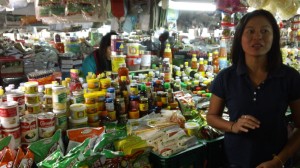
Learning all the different sauces in the market – think you could pick out what types of sauce to use out of all these choices?
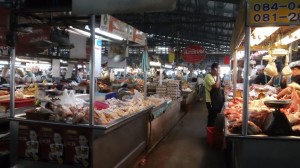
A small glimpse into the huge market, one of many around Chiang Mai and a typical setup that we’ve seen so far in Thailand.
The day started early with a trip to an open-air market just outside of town, where we learned the different types of sauces that go into thai food, such as fish sauce, mushroom sauce, soy sauce, chili paste, palm sugar and coconut milk. We also learned about the different types of rice based on the processing of it, along with the different dishes created with each type of rice. Then we toured the market on our own; Matt and I were especially fascinated with the meat section, where full pig heads were available for sale, along with just about any body part imaginable, along with chickens, fish, squid, and shrimp.
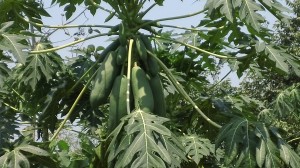
Papayas growing high up in the tree. Young, green ones are used for papaya salad and are a light green color, and when they are ripe, they are the orangish-red fruit that we’re all familiar with.
After the market, our group of 10 students were driven about 10 miles out of town to the school’s farm, where they grow all the ingredients, and where we toured the grounds, again learning about all the fresh ingredients that go into traditional dishes and the purpose they serve. This included kefir limes, galangal, ginseng, lemongrass, chilis…the list goes on and it took about an hour to look at all the freshly-grown ingredients.
By this time, our stomachs were growling, it was about 11am, and I wondered when we’d get to cooking. After putting a pot of jasmine rice in the rice cooker, along with putting a pot of sticky rice in the steamer, we started cooking our food. For the rest of the day, until 3pm, we cooked 5 different courses, including a soup, a curry dish, a noodle dish, an entrée and a dessert. Between Matt and I we cooked 10 different things, so being a couple had the benefit of testing 10 meals. It was so much food that we ended up taking half of it home for a meal the next day.
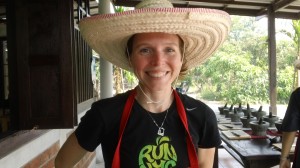
Julie, also ready to cook and explore the farm. You can see the mortars and pestles behind me, ready for us to make our curry pastes.
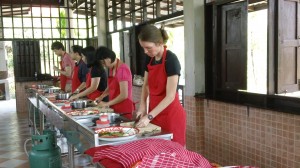
Myself and 4 other students learning how to cook 5 different courses. For each course, the teachers set up our trays with ingredients, we cut and prepped them, then told us in what order to cook them and for how long.
What surprised me the most about the cooking was how quickly each dish came together. Nothing had to be cooked for more than 3-5 minutes, if that, and even prepping the food was easy. I imagine once we get home, collecting all the hard-to-find ingredients will take the most time. Also, we made our curry pastes from scratch, starting with a mortar and pestle to grind all the ingredients together. I just might cheat at home and use my Cuisinart food processor for this step. Lastly, thai people really do love their fish sauce and their spicy chilis. Matt and I refrained from the fish sauce and when the teachers tasted our dishes, they immediately knew something was missing, and they even seemed sad when some students didn’t use any chilis in their dishes.
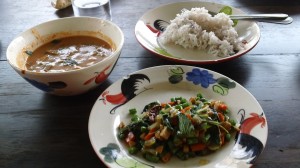
Matt’s creations, a vegetable and tofu stir-fry with thai basil and a sipcy red curry with vegetables and tofu.
Upon finishing the courses, we were all given cookbooks to take home, so we are now ready to show off our thai cooking to anyone willing to eat it, as long as we can find all the ingredients back home.
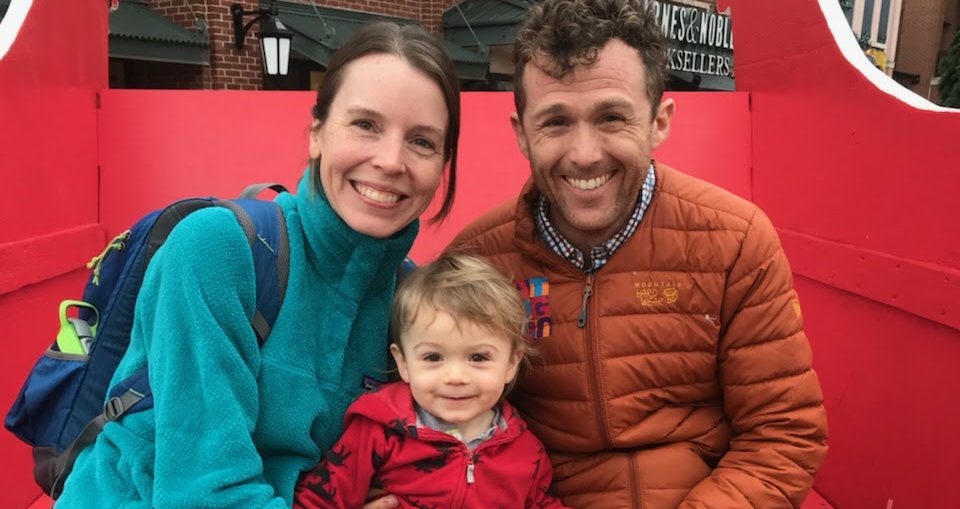


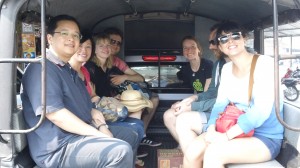
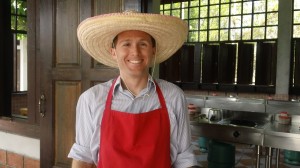
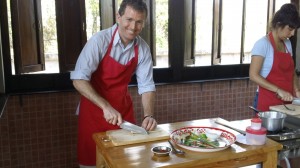
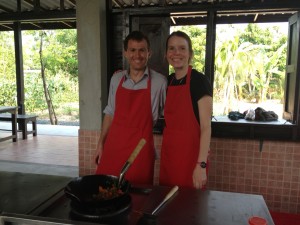
Pingback: Travel Lessons: SE Asia 2013 Urbyville